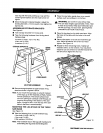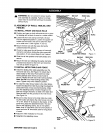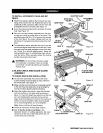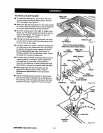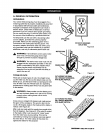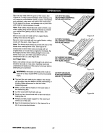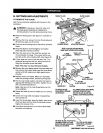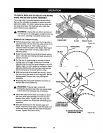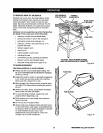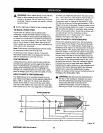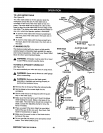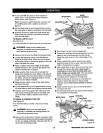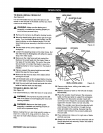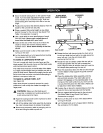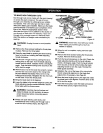
TO REDUCE RISK OF KICKBACK
Kickback can occur when the blade stalls or binds,
kickingthe workpiece back toward you with great
force and speed. If your hands are near the saw
blade, they may be jerked loose and thrown into the
blade. Obviously,kickback can cause seriousinjury,
and it is weUworth using precautions to avoid the
risks.
Kickback can be caused by any action that pinches
the blade in the wood, such as the following:
making a cut with incorrect blade depth
sawing into knots or nails in the workpiece
• twisting the wood while making a cut
making a cut with a dull, gummed-up, or im-
properly set blade
• failing to support work
forcing a cut
• cutting warped or wet lumber
misusing the saw
not following correct operating procedures
• failing to use the anti-kickback pawls
• using the wrong blade for the type of cut
TO AVOID KICKBACK
Use these guidelines to avoid kickback:
• Always use the correct blade depth setting.The
top point of the blade teeth shouldclear the work,piece,
1/8 inch to 1/4 inch.
• Inspect the work for knots or nails before beginning
a cut. Knock out any loose knots with a hammer.
Never saw into a loose knot or nail.
• Make straight cuts. Always use the rip fence when
rip cutting. This helps prevent twisting the wood in
the cut.
• Always use clean, sharp, and properly-set blades.
Never make cuts with dull blades.
• To avoid pinching the blade, support the work
properly before beginning a cut.
• When making a cut, use steady, even pressure.
Never force cuts.
• Do not cut wet or warped lumber.
• Always hold your workpiece firmly with both hands
or use push blocks, push sticks, and featherboards
to keep your body in a balanced position to be able
to resist kickback should it occur. Use
featherboards and push sticks to control non-
through cuts on small workpieces.
ANTI-KICKBACK
PAWLSIN PLACE
CORRECT
BLADEDEPTH
BLADE GUARD
IN PLACE
PUSHSTICK
NOKNOTS,NAILSORWARPSINWOOD,
WOODFEDANDSUPPORTEDCORRECTLY
Figure 33
PUSHSTICK
PUSHBLOCKS
Figure 34
25 £RRFTSMRN"TABLESAW315.228110



